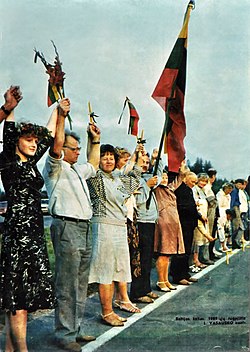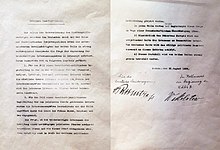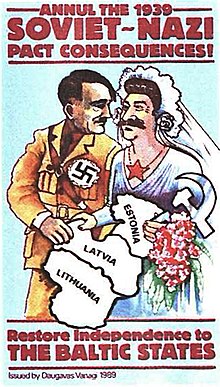
Back طريق البلطيق Arabic Cadena Báltica AST Baltik yolu Azerbaijani Baltėjės kels BAT-SMG Балтыйскі шлях Byelorussian Балтыйскі шлях BE-X-OLD Балтийски път Bulgarian Via Bàltica Catalan Baltský řetěz Czech Ffordd y Baltig Welsh
| Part of the Singing Revolution, the Revolutions of 1989, and the Dissolution of the Soviet Union | |
 | |
| Date | 23 August 1989 |
|---|---|
| Location | Estonia, Latvia and Lithuania (three countries occupied by the Soviet Union) |
| Also known as | Baltic Chain of Freedom |
| Cause | 50th anniversary of the Molotov–Ribbentrop Pact |
| Participants | About 2 million people |
| Outcome | Independence of the three countries was regained by August 1991 |
The Baltic Way (Lithuanian: Baltijos kelias; Latvian: Baltijas ceļš; Estonian: Balti kett) or Baltic Chain (also "Chain of Freedom"[1]) was a peaceful political demonstration that occurred on 23 August 1989. Approximately two million people joined their hands to form a human chain spanning 690 kilometres (430 mi) across the three Baltic states of Estonia, Latvia and Lithuania, which at the time were occupied and annexed by the USSR and had a combined population of approximately eight million.[2] The central government in Moscow considered the three Baltic countries constituent republics of the Soviet Union.
The demonstration originated in "Black Ribbon Day" protests held in the western cities in the 1980s. It marked the 50th anniversary of the Molotov–Ribbentrop Pact, in which Poland, Finland, Estonia, Latvia, Lithuania, and Romania were (as "spheres of influence") divided between the Soviet Union and Nazi Germany. The Soviet-Nazi pact led to the outbreak of World War II in September 1939 and the Soviet invasion and occupation of the Baltic countries in June 1940.
The 1989 event was organised by the Baltic pro-independence movements: Rahvarinne of Estonia, the Tautas fronte of Latvia, and Sąjūdis of Lithuania, to draw global attention by demonstrating a popular desire for independence and showcasing solidarity among the three nations. It has been described as an effective publicity campaign, and an emotionally captivating and visually stunning scene.[3][4]
The event presented an opportunity for the Baltic activists to publicise the Soviet rule and position the question of Baltic independence not only as a political matter, but also as a moral issue. The Soviet authorities responded to the event with intense rhetoric,[3] but failed to take any constructive actions that could bridge the widening gap between the Baltic republics and the rest of the Soviet Union. Seven months after the protest Lithuania became the first Soviet republic to declare independence.


After the Revolutions of 1989, 23 August has become an official remembrance day both in the Baltic countries, in the European Union and in other countries, known as the Black Ribbon Day or as the European Day of Remembrance for Victims of Stalinism and Nazism.
- ^ Wolchik, Sharon L.; Jane Leftwich Curry (2007). Central and East European Politics: From Communism to Democracy. Rowman & Littlefield. p. 238. ISBN 978-0-7425-4068-2.
- ^ Aliide Naylor, The Shadow in the East: Vladimir Putin and the New Baltic Front (2020).
- ^ a b Dreifelds, Juris (1996). Latvia in Transition. Cambridge University Press. pp. 34–35. ISBN 0-521-55537-X.
- ^ Anušauskas 2005, p. 619.
© MMXXIII Rich X Search. We shall prevail. All rights reserved. Rich X Search